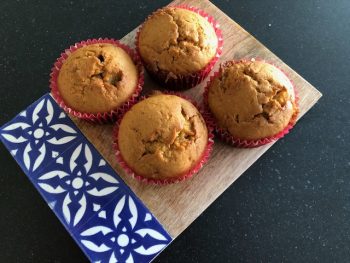Cooking in Lockdown: Banana Bread Posted by Karoly Molina on May 21, 2020 in Uncategorized
The recent COVID-19 crisis has brought out the cook or cocinero in most of us. There are so many people sharing recetas or recipes online as well as some very funny fracasos or fails in the kitchen. I am not much of a baker, but a recent accumulation of plátanos or bananas motivated me to make banana muffins.
La receta
I am much more of a cook than a panadera or baker, but banana bread is one of the few basic recipes I can easily make. The most important thing to remember is that your bananas should be very very ripe or maduros! The mushier and darker the banana is, the better the bread. Based on several recipes I’ve come across, over ripe bananas will provide moisture and sweetness. Other important tips to remember are that you can use harina blanca or plain white flour or harina integral or whole wheat flour. You can also substitute the milk for non-dairy options. Same thing for the type of sugar or azúcar you use. I would, however, consult online recommendations for using sugar substitutes. You can also add extras like nuts or chocolate or even more chunks of banana.
Ingredientes
- 8 cucharadas o 113 gramos de mantequilla sin sal (unsalted butter) a temperatura ambiente (room temperature)
- 1 taza de azúcar granulada
- 2 huevos
- 1/4 de taza de leche
- 1 cucharada de extracto de vainilla (vanilla extract)
- 3 plátanos muy muy muy maduros
- 2 tazas de harina
- 1 cucharadita de bicarbonato de sodio (baking soda)
- 1/4 cucharadita de sal
- 1/2 taza de nueces o chispas de chocolate (opcional)
- 1 molde de pan o para cupcakes/magdalenas
Instrucciones
- Calienta el horno a 350° F o 180° C y acomoda la bandeja en la parte baja de tu horno.
- Prepara tu molde ya sea con suficiente mantequilla o con papel pergamino (parchment paper). Si usas molde para cupcakes, puedes usar moldes de papel para magdalenas (cupcake liners).
- En un bol grande, combina la mantequilla y el azúcar. Puedes hacer esto con un tenedor o con una batidora (mixer).
- Agrega los huevos uno por uno batiendo muy bien.
- Agrega la leche y el extracto de vainilla, igual batiendo muy bien para que se incorporen a la mezcla.
- Agrega los plátanos en pedazos y mezcla muy bien. Si estas mezclando con un tenedor, es mas fácil machacar (crush) los plátanos aparte y luego incorporar a la mezcla.
- Agrega la harina, bicarbonato y sal poco a poco hasta que se incorporen.
- Dobla (fold) las nueces o chispas de chocolate (o ambas!).
- Agrega la mezcla a tu molde. Si son magdalenas, llena solo 3/4 de cada molde.
- Hornea por 50 minutos si es panqué y 20 si son magdalenas. Es importante checar el pan ya que cada horno es diferente. Para checar que el pan o las magdalenas están listas en el horno, inserta un palillo en el centro. Si este sale limpio, ya las puedes sacar del horno.
- Deja el panqué reposar por 10 minutos antes de sacarlo del molde.
Tips
Like I mentioned above, this recipe adapts well to white or wheat flour as well as the type of sugar. You can top it with chocolate chips or nuts or even mix these before baking. If you are vegan, I found a delicious recipe for banana and chocolate bread. You might notice some different terms. In the video, Marta uses banana and plátano and the use varies per Spanish speaking region. In Mexico, we say plátano, but most would understand if you said banana. She also calls chocolate chips pepitas de chocolate, but you can also call them chispas de chocolates.
Are you more of a panadero or cocinero? What have you been making during the lockdown?

Build vocabulary, practice pronunciation, and more with Transparent Language Online. Available anytime, anywhere, on any device.





Comments:
Brian Francisco:
Nice recipe. Yo tambien trying to learn Spanish. Soy de las Islas Filipinas. Nosotros Filipinos no longer speak fluent spanish. Only a small number of Filipinos still speaks Spanish. And only in ciudad de zamboanga that Chavacano (a Spanish creole language is widely spoken.